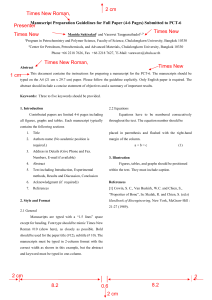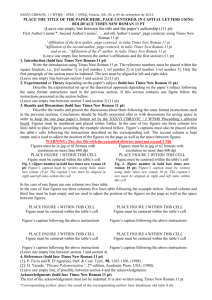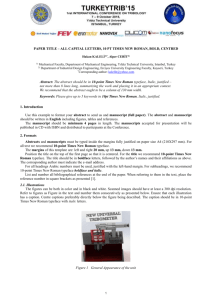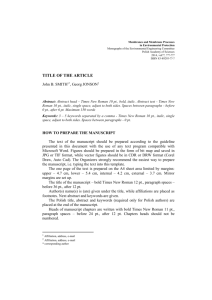Electronic format submission for Ursi2004
advertisement
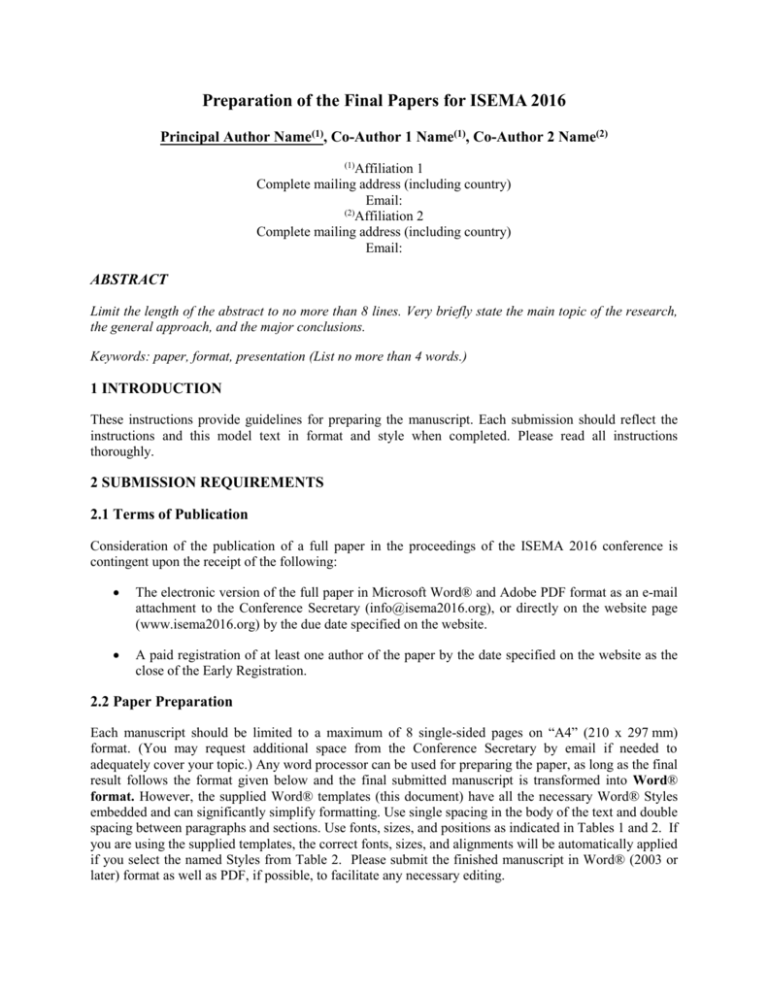
Preparation of the Final Papers for ISEMA 2016 Principal Author Name(1), Co-Author 1 Name(1), Co-Author 2 Name(2) (1) Affiliation 1 Complete mailing address (including country) Email: (2) Affiliation 2 Complete mailing address (including country) Email: ABSTRACT Limit the length of the abstract to no more than 8 lines. Very briefly state the main topic of the research, the general approach, and the major conclusions. Keywords: paper, format, presentation (List no more than 4 words.) 1 INTRODUCTION These instructions provide guidelines for preparing the manuscript. Each submission should reflect the instructions and this model text in format and style when completed. Please read all instructions thoroughly. 2 SUBMISSION REQUIREMENTS 2.1 Terms of Publication Consideration of the publication of a full paper in the proceedings of the ISEMA 2016 conference is contingent upon the receipt of the following: The electronic version of the full paper in Microsoft Word® and Adobe PDF format as an e-mail attachment to the Conference Secretary (info@isema2016.org), or directly on the website page (www.isema2016.org) by the due date specified on the website. A paid registration of at least one author of the paper by the date specified on the website as the close of the Early Registration. 2.2 Paper Preparation Each manuscript should be limited to a maximum of 8 single-sided pages on “A4” (210 x 297 mm) format. (You may request additional space from the Conference Secretary by email if needed to adequately cover your topic.) Any word processor can be used for preparing the paper, as long as the final result follows the format given below and the final submitted manuscript is transformed into Word® format. However, the supplied Word® templates (this document) have all the necessary Word® Styles embedded and can significantly simplify formatting. Use single spacing in the body of the text and double spacing between paragraphs and sections. Use fonts, sizes, and positions as indicated in Tables 1 and 2. If you are using the supplied templates, the correct fonts, sizes, and alignments will be automatically applied if you select the named Styles from Table 2. Please submit the finished manuscript in Word® (2003 or later) format as well as PDF, if possible, to facilitate any necessary editing. If there are authors with different affiliations, the complete affiliation should be given for each of them using superscripts in the list of authors to refer to the affiliations. The name of the corresponding author should be underlined. Equations should be centered and numbered consecutively, with equation numbers in parentheses flush with the right margin. Use italic Roman and Greek symbols for quantities and variables both in the equations and in the text. Punctuate equations with commas or periods when they are part of a sentence. Be sure that the symbols in your equation have been defined before the equation appears or immediately after it. Use “(1)” not “Eq. (1)” or “Equation (1)” except at the beginning of a sentence, then use “Equation (1) is....”. An example of an equation line is: Ts Tb , 1 (Tb ) ln (1) where Ts is…, Tb… Table 1: Page layout Paper size A4 210 x 297 mm (8.2 x 11.6 inch) Margins Top 25 mm (~1 inch) Bottom 25 mm (~1 inch) Left 25 mm (~1 inch) Right 25 mm (~1 inch) Text Layout The text of the manuscript should be composed with indicated fonts, sizes and line spacing in Table 2. Full justification should be used for the body of the text where possible. Do not add page numbers. These will be added to the final combined document. Table 2: Fonts and sizes Style Name Font, Style, Position Font Size ISEMA Title Times New Roman, Bold, Center 14 ISEMA Author(s) Times New Roman, Bold or Bold, Center Times New Roman, Normal, Center 12 ISEMA Affiliation(s) ISEMA ABSTRACT Times New Roman, Bold Italic, Left Times New Roman, Italic, Justified ISEMA Abstract text Times New Roman, Italic, Left ISEMA Keywords Times New Roman, Bold: Italic, Center ISEMA Fig.:Caption Times New Roman, Normal, Center ISEMA Figure Times New Roman, Bold: Italic, Center ISEMA Table:Caption Times New Roman, Normal, Center ISEMA Table Times New Roman, Normal, Right ISEMA Equation Line 11 12 11 11 11 11 11 11 11 ISEMA Heading level 3 Times New Roman, BOLD, Left Times New Roman, Bold, Left Times New Roman, Bold-Italic, Left ISEMA Reference text Times New Roman, Normal, Left 10 ISEMA All other text Times New Roman, Normal, Justified 11 ISEMA HEADING 1& REF. ISEMA Heading level 2 12 12 11 2.2.1 Captions and figures Figure captions should be centered below the figures; table captions should be centered above the tables. Avoid placing figures and tables before they have been first mentioned in the text. Use the abbreviation “Fig. 1,” even at the beginning of a sentence. All images must be embedded into your document. Color figures may be included for additional clarity in electronic form, but all colors should be selected for legibility when printed in gray scale in the Proceedings. Data series and curves must be identifiable by means other than color. The type of graphics you include will affect the quality and size of your electronic paper. Please be sure your images have sufficient resolution to print and reproduce well. An example of an image embedded in a document is given in Fig. 1. Fig. 1: Imaginary part of permittivity of pure (0 %) and saline (3.4 %) water. 3 REFERENCE CITATIONS Number citations consecutively in square brackets as “[1].” The sentence punctuation follows the brackets. Refer simply to the reference number, as in [2]. Do not use “Ref.[2]” or “reference [2]” except at the beginning of a sentence: “Reference [2] was the first....”. With several references, the recommended formatting is [3],[4]-[6]. In the list of references, use the formatting rules applied in IEEE publications. Examples of reference items for different categories shown in the REFERENCES section include: example of a book in [1] example of a book in a series in [2] example of a journal article in [3] example of a conference paper in [4] example of a patent in [5] example of a website in [6] example of a web page in [7] example of a data book as a manual in [8] example of a datasheet in [9] example of a master’s thesis in [10] example of a technical report in [11] example of a standard in [12] Give all authors’ names; do not use “et al”. Papers that have not been published, even if they have been submitted for publication, should be cited as “unpublished”. Papers that have been accepted for publication should be cited as “in press”. REFERENCES [1] S. M. Metev and V. P. Veiko, Laser Assisted Microtechnology, 2nd ed., R. M. Osgood, Jr., Ed. Berlin, Germany: Springer-Verlag, 1998. [2] J. Breckling, Ed., The Analysis of Directional Time Series: Applications to Wind Speed and Direction, ser. Lecture Notes in Statistics. Berlin, Germany: Springer, 1989, vol. 61. [3] S. Zhang, C. Zhu, J. K. O. Sin, and P. K. T. Mok, “A novel ultrathin elevated channel low-temperature polySi TFT,” IEEE Electron Device Lett., vol. 20, pp. 569–571, Nov. 1999. [4] M. Wegmuller, J. P. von der Weid, P. Oberson, and N. Gisin, “High resolution fiber distributed measurements with coherent OFDR,” in Proc. ECOC’00, 2000, paper 11.3.4, p. 109. [5] R. E. Sorace, V. S. Reinhardt, and S. A. Vaughn, “High-speed digital-to-RF converter,” U.S. Patent 5 668 842, Sept. 16, 1997. [6] (2002) The IEEE website. [Online]. Available: http://www.ieee.org/ [7] M. Shell. (2002) IEEEtran homepage on CTAN. [Online]. Available: http://www.ctan.org/texarchive/macros/latex/contrib/supported/IEEEtran/ [8] FLEXChip Signal Processor (MC68175/D), Motorola, 1996. [9] “PDCA12-70 data sheet,” Opto Speed SA, Mezzovico, Switzerland. [10] Karnik, “Performance of TCP congestion control with rate feedback: TCP/ABR and rate adaptive TCP/IP,” M. Eng. thesis, Indian Institute of Science, Bangalore, India, Jan. 1999. [11] J. Padhye, V. Firoiu, and D. Towsley, “A stochastic model of TCP Reno congestion avoidance and control,” Univ. of Massachusetts, Amherst, MA, CMPSCI Tech. Rep. 99-02, 1999. [12] Wireless LAN Medium Access Control (MAC) and Physical Layer (PHY) Specification, IEEE Std. 802.11, 1997.
